Abstract
Although there are many continuous distributions in the literature, only a handful take advantage of the modeling power provided by trigonometric functions. To our knowledge, none of them are based on the so-called secant function, defined as the reciprocal of the cosine function. The secant function can go to large values whenever the cosine function goes to small values. The idea is to profit from this trigonometric property to modify well-known distribution tails and overall skewness features. With this in mind, in this paper, a new class of trigonometric distributions based on the secant function is introduced. It is called the Sec-G class. We discuss the main mathematical characteristics of this class, including series expansions of the corresponding cumulative distribution and probability density functions, as well as several probabilistic measures and functions. In particular, we present the moments, skewness, kurtosis, Lorenz, and Bonferroni curves, reliability coefficient, entropy measure, and order statistics. Throughout the study, emphasis is placed on the unique four-parameter continuous distribution of this class, defined with the Kumaraswamy-Weibull distribution as the baseline. The estimation of the model parameters is performed using the maximum likelihood method. We also carried out a numerical simulation study and present the results in graphic form. Three referenced datasets were analyzed, and it is proved that the proposed secant Kumaraswamy-Weibull model outperforms important competitors, including the Kumaraswamy-Weibull, Kumaraswamy-Weibull geometric, Kumaraswamy-Weibull Poisson, Kumaraswamy Burr XII, and Weibull models.
Keywords:
trigonometric class of distributions; secant function; Kumaraswamy-Weibull distribution; maximum likelihood estimation AMS Subject Classification:
60E05; 62E15; 62F10
1. Introduction
Standard (continuous) distributions do not provide enough modeling flexibility to acceptably evaluate all types of data. It is especially true for data with unusual tails, skewness, or kurtosis characteristics. To bridge that gap, researchers have proposed many classes of distributions in recent literature, attempting to broaden the properties of existing distributions. The majority are created by changing basic baseline distributions. The most popular transformations are those that rely on analysis operators (power, integral, composition, …) and one or more tuning parameters. The unavoidable works in this regard are those of [1], introducing the exp-G class, Reference [2], presenting the Kumaraswamy-G class, Reference [3], introducing the Marshall–Olkin-G class, Reference [4], developing the beta-G class, and [5] introducing the gamma-G class. We also refer the reader to Table 1 of [6], which provides an exhaustive list of the most useful ones, with the references therein. Even with the advancements of modern applied science experiments, there is still a growing requirement for adaptable statistical models to adapt to all kinds of data, leading to the development of new approaches based on novel analytical techniques.
On the other hand, trigonometric functions have examples in different areas, such as mathematics, physics, biology, and engineering. The sine distribution was proposed by [7] in the last century. The model’s creation arose from the need to calculate the impact angles on the moon’s craters caused by the meteorite. In this context, Reference [8] proposed a system of distributions where the two cumulative distribution functions (CDFs) depend exclusively on tangent and sine functions, known as Burr type V and Burr type XI distributions. Although these distributions are not the most preferred by researchers, both distributions have numerous applications. Reference [9] proposed using the cosine distribution to approximate the normal distribution. The Beta trigonometric distribution, proposed by [10], can be used to model economic data. These famous circular distributions can be used in many applications, such as insect life, widely applied in geology [11]. In many phenomena, circular measurements, such as the movement direction of an animal after a given stimulus, wind direction analysis, the arrival time of a patient in a hospital, and insect visits in flowers, are also analyzed by these circular distributions.
As a result, logically, there is a growing interest in new distributions and classes of distributions based on trigonometric functions , , , etc. Such classes take advantage of the curvature properties of these trigonometric functions to produce flexible distributions with desirable properties, in terms of modeling. In particular, greater power is gained in the tails without including new parameters. We can point the reader to the works of [12,13,14,15,16,17,18,19,20]. To the best of our knowledge, no class of distributions is centered on the secant function, defined as the reciprocal of the cosine function . When the cosine function takes small values, the secant function takes large values. This characteristic could be useful for changing the tails and overall skewness of an existing distribution. With this in mind, in this research, we aimed to develop and analyze the secant generated (Sec-G) class of distributions, which are described by the following CDF:
where is a CDF of a baseline (continuous) distribution depending on one or several parameters represented by . Further motivations behind the Sec-G class are the following ones:
- (a)
- Every chosen baseline distribution leads to a previously unstudied trigonometric distribution.
- (b)
- The corresponding CDF has a tractable expression, implying the same for all related functions (such as the probability density, hazard rate, and quantile functions), and there is no additional parameter to those of the baseline distribution.
- (c)
- One can prove that the following first-order stochastic dominance property: for any , we haveIt means that the Sec-G class stochastically dominates its baseline distribution; it provides a real alternative model compared to the baseline model in the CDF sense. For instance, the Sin-G class by [13,14] satisfies the exact reversed first-order stochastic dominance property, which makes the Sec-G class a complementary solution.
- (d)
- Thanks to the well-known series expansion function of the secant function, simple series expansions of some important functions are feasible.
- (e)
- More secondary, if we attempt to link the Sec-G class to the actual literature, we remark that it belongs to the general classes of distributions proposed by [21,22]. Indeed, we have , where defines a (new) generator probability density function (PDF).
- (f)
- The statistical models developed by the Sec-G class are manageable in terms of computing. They may be employed effectively in a real-data analysis situation.
All of those points are developed and discussed throughout the rest of the study. We emphasize the famous Kumaraswamy-Weibull (Kum-W) distribution introduced by [23] as the baseline, intending to create an alternative trigonometric four-parameter distribution with different levels of functionalities. This paper will show how the proposed distribution can outperform the goodness-of-fit power of the Kum-W distribution in a concrete data analysis scenario.
The paper is as follows: Section 2 provides the essential functions of the Sec-G class, with a focus on the Kum-W distribution as the baseline. The main properties of the class are discussed in Section 3. Applications to simulated and real-life data are given in Section 4. Some concluding remarks are formulated in Section 5.
2. Basics on the Sec-G Class
Here, we complete the presentation of the Sec-G class, with a focus on its main functions of interest.
2.1. Main Functions
First, we recall that the Sec-G class is defined by the CDF , given by Equation (1). Clearly, by the definition of , the support of the corresponding distribution corresponds to the support of the baseline distribution. In addition, it is worth noting that the Sec-G class is identifiable if and only if the baseline distribution is identifiable. That is, the equality is equivalent to , which is equivalent to .
As another important function of the Sec-G class, the survival function, is given by , that is
Upon differentiation of with respect to x, the corresponding PDF is given by
where denotes the PDF corresponding to .
Moreover, the cumulative hazard rate function of the Sec-G class can be expressed as ; that is
The corresponding hazard rate function (HRF) is obtained upon differentiation of with respect to x; that is
These functions are essential for analyzing all possibilities of the Sec-G class in a practical setting. In particular, functions and are very informative about the modeling properties of the related distributions; the more they show various forms of shapes, the more the flexibility of the related distribution is desirable from a statistical point of view.
Another important function is the quantile function, defined as the inverse function of . After some algebra, we get
where denotes the quantile function corresponding to and denotes the arcsecant function, defined as the inverse function of , i.e., . To our knowledge, the Sec-G class is the first one with a quantile function depending on the arcsecant function. Then, we can express the three quartiles, including the median, as . We can also define some measures of skewness and kurtosis, such as the MacGillivray skewness proposed by [24] and the Moors kurtosis introduced by [25]. Finally, by considering a random variable U following the uniform distribution over , we can generate values from the Sec-G class from generated values from U, by using the fact that has the CDF of the Sec-G class as defined by Equation (1).
2.2. On the Shapes of the PDF and HRF
Here, we derive the basics on the shapes of the PDF and HRF of the Sec-G class. First, the derivative of with respect to x is
Thus, the critical point(s) of is (are) the root(s) of the following non-linear equation: . Such a critical point, say , corresponds to a local maximum, a local minimum, or a point of inflection, depending on whether , or , where .
The same methodology holds for the HRF of the Sec-G class. Indeed, the derivative of with respect to x is
Thus, the critical point(s) of is(are) the root(s) of the following non-linear equation: . Again, such a critical point, say , corresponds to a local maximum, a local minimum or a point of inflection, depending on whether , or , where .
Let us now derive some asymptotic results on these functions. First, we recall that: when , and , and, when , and . Therefore, when , we have the following equivalences:
Moreover, when , we have the following equivalences:
For a given baseline CDF , these results are helpful in determining the asymptotic comportments of the PDF and HRF of the corresponding distribution. This point is illustrated in the next subsection by considering a special member of the Sec-G class.
2.3. The Sec-Kum-W Distribution
The Sec-G class, due to its original definition, contains many new trigonometric distributions. Here, a promising one is presented. The Kum-W distribution defined it as the baseline. As a brief description, the Kum-W distribution was introduced by [23] with the CDF given by
where , is a scale parameter, and are shape parameters, and the PDF is given by
The Kum-W distribution contains many well-referenced distributions. The most notable ones are the Weibull, exponentiated Weibull, and exponentiated exponential distributions (see [26]). Other examples are provided in Table 1 of [23]. The Kum-W distribution supports all five major HRF shapes: constant, increasing, decreasing, bathtub, and unimodal. In the last decade, the Kum-W distribution proved to be one of the more efficient lifetime distributions for data analysis. For further information, see, for instance [27,28,29].
Thus, in this part, we propose an extension of the Kum-W distribution that first-order stochastically dominates it, with a similar level of flexibility. We define the Sec-Kum-W distribution by the CDF given by Equation (1) with as the CDF of the Kumaraswamy-Weibull distribution; that is
It thus satisfies the following first-order stochastic dominance property: for any . Then, all of the functions presented in the previous section can be expressed. In particular, the corresponding PDF and HRF are, respectively, obtained as
and
Moreover, the quantile function of the Sec-Kum-W distribution is specified by
In particular, this analytical expression allows us the simulation of random values from the Sec-Kum-W distribution.
The critical points and asymptotic properties of and can be determined by using the non-linear equations presented in the above section. Due to their analytical complexity, a mathematical software can help to obtain precise calculations of the critical points. On the other hand, by using Section 3 of [23], we arrive at the following equivalences. When , we get
Moreover, when , we have the following equivalences:
As a consequence, when , for , for , and for . The same asymptotes hold for . Moreover, when , in all circumstances, whereas for , for , and for . One can remark that, as for the former Kumaraswamy-Weibull distribution, the (asymptotic) tails of are of different nature: the upper tail is of exponential type whereas the lower tail is of polynomial type.
The main interest of the Sec-Kum-W distribution is to possess very flexible PDF and HRF. This aspect is difficult to reveal from an analytical approach, which motivates us to provide graphic evidence. Thus, Figure 1 and Figure 2 present some curves of these two functions for selected values of the parameters, respectively.
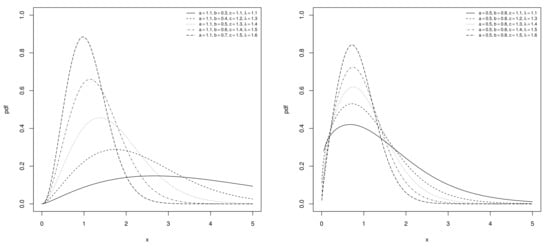
Figure 1.
Plots of the PDF of the Sec-Kum-W distribution for some selected values of the parameters.
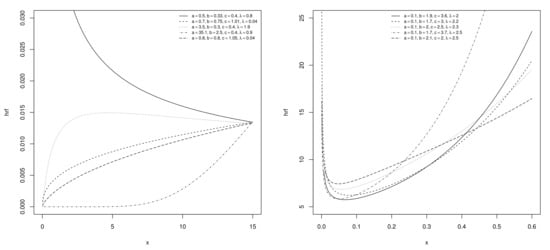
Figure 2.
Plots of the HRF of the Sec-Kum-W distribution for some selected values of the parameters.
We see in Figure 1 that the PDF of the Sec-Kum-W distribution presents great flexibility in the central and dispersion parameters (mean, modes, variance…), skewness, and kurtosis, observing highly-right skewed as well as near-symmetrical curves. Comparatively, the Sec-Kum-W distribution’s PDF is more flexible in the right tail and kurtosis level than the PDF of the Kum-W distribution. However, it appears less likely to modulate the left tail (see Figure 1 of [23]).
From Figure 2, we see that the corresponding HRF can have constant, increasing, decreasing, bathtub, and unimodal shapes. Moreover, different levels of convexity–concavity are observed. From the statistical modeling point of view, these are very desirable properties. Comparatively, we can observe that the HRF of the Sec-Kum-W distribution can be increasing and concave (for , for instance), which is less immediate for the HRF of the Kum-W distribution (see Figure 2 of [23]).
3. Mathematical Properties
Here, the main mathematical properties of the Sec-G class are derived, with applications to the Sec-Kum-W distribution when appropriate.
3.1. Useful Series Expansions
The following result presents useful series expansions for the CDF and PDF of the Sec-G class in terms of CDFs and PDFs of the exp-G class introduced by [1].
Theorem 1.
The CDF and PDF of the Sec-G class given by Equations (1) and (2) can be expressed as
respectively, where
is the Euler number, and , which are the CDF and PDF of the exp-G class with a power parameter of , respectively.
Proof.
The proof is centered around the following well-established result. For any , the secant function has the following series expansion:
We may refer the reader to [30], and the references therein. Therefore, since , we can express the CDF of the Sec-G class as
Upon differentiation of the above function with respect to x, the desired series expansion for follows. This ends the proof of Theorem 1. □
As an example, let us consider the Sec-Kum-W distribution, defined by the CDF and PDF given by Equations (3) and (4), respectively. Then, the CDF of the Sec-Kum-W distribution can be expressed as
with, by applying the (standard and generalized) binomial formula three times in a row,
Moreover, the corresponding PDF can be expressed as
where
and , corresponding to the PDF of the Weibull distribution with scale parameter of and shape parameter of c.
We can notice that and correspond to the CDF and PDF of the exponentiated Kumaraswamy-Weibull distribution with a power parameter of , respectively, which was studied in [27]. Thus, some results in [27] can be transposed in the context of the Sec-Kum-W distribution.
3.2. Moments
We now investigate some exploitable expressions for various moments or derivations. Let X be a random variable having the CDF and PDF of the Sec-G class given by Equations (1) and (2), respectively. Then, for any function providing that the coming integral term exists, we have
In most cases, the integral term can be calculated numerically by the use of a mathematical software. A tractable series expansion is also available based on Theorem 1; we have
According to the complexity of , the integral term can have an analytical expression. Thus, for a large integer K, the following finite sum can provide a suitable approximation for :
Table 1 lists several well-known measures or functions related to the concept of moments based on specific choices for , including the mean, raw moments, variance, central moments, moment generating function, characteristic functions, and incomplete moments.

Table 1.
Well-known measures or functions related to the concept of moments.
The result below illustrates the interest of Equation (8) by determining a tractable series expansion for the raw moment of a random variable following the Sec-Kum-W distribution.
Proposition 1.
Proof.
Now, by applying the change of variable , we get
This ends the proof of Proposition 1. □
With a slight modification, the incomplete moment of a random variable following the Sec-Kum-W distribution is given in the next result.
Proposition 2.
The proof of Proposition 2 follows the one of Proposition 1. It is thus omitted.
For measuring and visualizing income inequalities, the Bonferroni and Lorenz curves are commonly used. The Lorenz curve, denoted by , is the proportion of total income volume accumulated by those units with an income less than or equal to a certain volume, and the Bonferroni curve, denoted by , is the scaled conditional mean curve; that is, the population’s ratio of group mean income. In the setting of the Sec-G class, and are defined by
respectively. The plots of these two kinds of curve in the case of the Sec-Kum-W distribution are given in Figure 3 for , , and , and selected values for a.
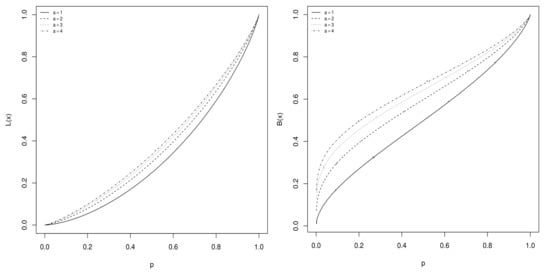
Figure 3.
Plots of and for the Sec-Kum-W distribution for , , and , and selected values for a, and varying p.
We see that, for the considered values of the parameters, is increasing and convex, whereas is increasing with a tilde shape (concave, then convex, then concave).
For the special Sec-Kum-W distribution, the moment measures and can be derived from Proposition 1 and Proposition 2, respectively.
We can express the central moments, moment generating function, and characteristic function in a similar manner. In addition, from the central moments and variance of X, we can define the general coefficient of the Sec-G class as
Then, and are used to calculate skewness and kurtosis. Thus, depending on , , or , the sign of informs on the distribution’s left, symmetric, or right skewed nature, whereas the value of informs on its tailedness. In order to see the numerical capabilities of these measures, some graphics are provided. For some parameter values of b, c, and , the skewness and kurtosis coefficients for the Sec-Kum-W distribution are plotted as functions of a in Figure 4, and as functions of b in Figure 5. In addition, for some parameter values of a, b, and , they are plotted as functions of c in Figure 6.
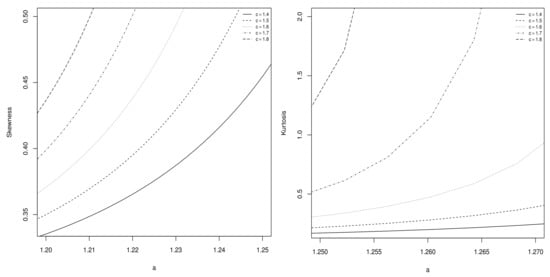
Figure 4.
Plots of skewness and kurtosis coefficients of the Sec-Kum-W distribution as functions of a for , , and selected values of c.
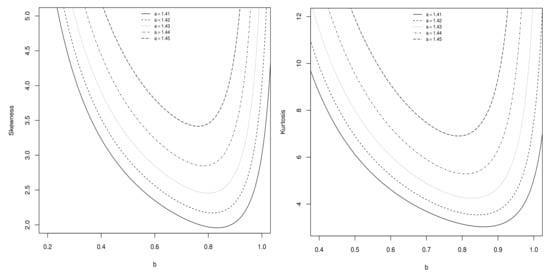
Figure 5.
Plots of skewness and kurtosis coefficients of the Sec-Kum-W distribution as functions of b for , , and selected values of a.
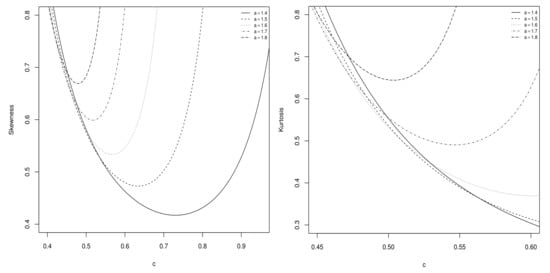
Figure 6.
Plots of skewness and kurtosis coefficients of the Sec-Kum-W distribution as functions of c, for , , and selected values of a.
3.3. Coefficient of Reliability
We are now studying the coefficient of reliability of the Sec-G class via the concept described in [31]. Mathematically, it is expressed as
where denotes the PDF of the Sec-G class as in Equation (2) with a baseline CDF given by , and denotes the CDF of the Sec-G class as in Equation (1) with a baseline CDF given by . Hence, it is assumed that and are two parameter vectors, possibly different. The integral expression of R can be complicated to determine due to the complexity of the involved functions. However, a series expansion is possible thanks to the expansion of and . From Equations (5) and (6), as well as the interchanged integral and sum signs, it follows that
In an expanded form, we obtain
For given and , this integral can be computed numerically.
As a consequence, if one can assume the existence of such that , then we have the following simple series expansion:
For , we get the expected .
3.4. Entropy Measure
The entropy of a distribution can be presented as a measure of uncertainty; the higher the entropy, the higher the disorder and the lower the chance of seeing a specific event. This part focuses on the Rényi entropy of the Sec-G class, as defined in a general way in [32]. Let and . Then, the Rényi entropy of the Sec-G class is specified by
The calculus of is still possible with mathematical software. We propose here a series expansion approach. By virtue of the Taylor series of the function at a given point , we can write
where .
We get the following result after some algebra and the swapping of the integral and sum signs:
In the vast majority of cases, can be computed numerically. This can be done for the Sec-Kum-W distribution, for instance. As a side note, the famous Shannon entropy is given by . It corresponds to the limit case of when tends to 1. Figure 7 presents some plots of the Rényi entropy for the Sec-Kum-W distribution with selected parameter values and varying .

Figure 7.
Plots of the Rényi entropy of the Sec-Kum-W distribution as functions of for selected parameter values.
Figure 7 reveals a wide panel of shapes for the Rényi entropy of the Sec-Kum-W distribution, illustrating an undeniable entropy flexibility.
3.5. Order Statistics
Order statistics can be used in a variety of mathematical theories and applications. Here, we look at some of the distributional properties of the order statistic from the Sec-G class. Let be n random variables from a random sample of the Sec-G class. Then, the PDF of the order statistic, say , is given by
That is, in an expanded form, we have
It follows from the binomial formula applied two times that
where .
As a result, for any function providing that the coming integral term exists, we have
In most cases, the integral term can be calculated numerically by the use of mathematical software. This is the case for all the functions listed in Table 1 and the setting of the Sec-Kum-W distribution. In Figure 8, we plotted the PDFs of the order statistics for a sample of size from a Sec-Kum-W distribution with the parameters equal to , , and .
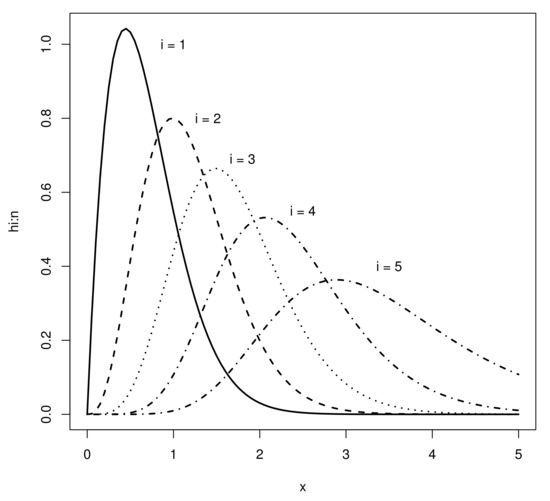
Figure 8.
Plots of PDFs of order statistics for a sample of size of the Sec-Kum-W distribution, with parameters , , and .
From Figure 8, we see that the value of i mainly affects the skewness and kurtosis nature of the distributions.
3.6. Maximum Likelihood Method
Let be a vector with p parameters and be a vector of n values from the Sec-G class. Then, we can estimate by maximum likelihood method, which suggests the estimate
where denotes the likelihood function defined as
Thus defined, is called the maximum likelihood estimate (MLE) of . We also have , where denotes the log-likelihood function defined as , i.e.,
Assuming that is differentiable with respect to , is the simultaneous solution of the following non-linear equations: , for , with
Under some well-known regularity conditions, the asymptotic distribution of can be approximated by a well-identified multivariate normal distribution (with covariance matrix defined from the observed Fisher information matrix). Then, from this result, we can construct approximate confidence intervals as well as likelihood ratio tests. More basically, we can derive the estimated PDF by the substitution technique; is an estimated function of . The same idea can be applied to any other functions of the Sec-Kum-W distribution.
In the context of the Sec-Kum-W distribution, the expression of can be found in Equations (27)–(30) of [23].
4. Numerical Study
Here, we turn out the Sec-Kum-W distribution as a statistical model, and illustrate its applicability with simulated data and real-life data.
4.1. Simulation
First, we operate a simulation study to show the efficiency of the MLEs of the Sec-Kum-W model parameters. To this aim, the seckw R package is used, developed by [33]. The parameter configuration is: , , and . We choose samples of moderate sizes, between 1 and 250, and we run 1000 replicas for each sample size. Figure 9, Figure 10, Figure 11 and Figure 12 show the biases and mean squared errors (MSEs) for a, b, c and considered as functions of n, respectively.
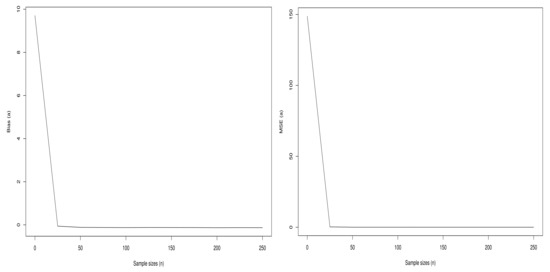
Figure 9.
Plots of the biases and MSEs of the parameter a of the Sec-Kum-W distribution.
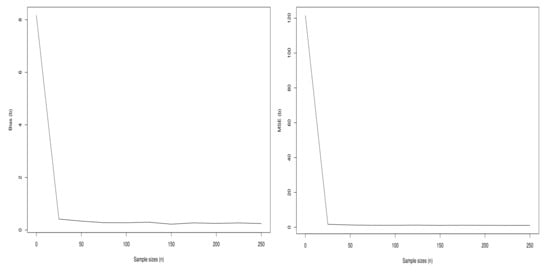
Figure 10.
Plots of the biases and MSEs of the parameter b of the Sec-Kum-W distribution.
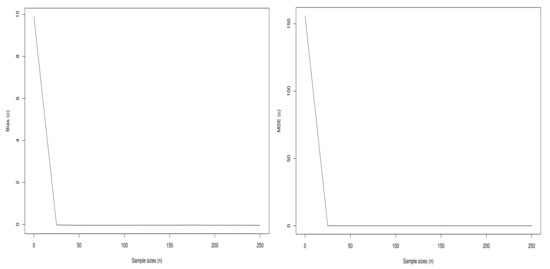
Figure 11.
Plots of the biases and MSEs of the parameter c of the Sec-Kum-W distribution.
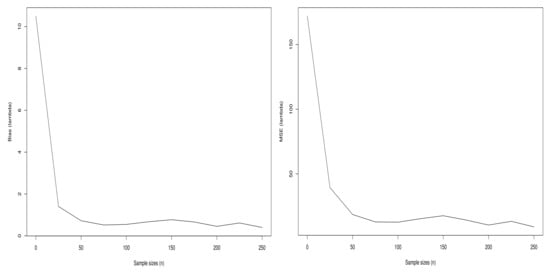
Figure 12.
Plots of the biases and MSEs of the parameter of the Sec-Kum-W distribution.
From Figure 9, Figure 10, Figure 11 and Figure 12, we observe that the curves of the bias tend to 0 when n increases. In addition, as anticipated, the curves of the MSEs decrease to 0 when n increases.
Table 2 summarizes the simulation results, given the means of MLEs, biases and MSEs for , 50 and 250.

Table 2.
Values of the MLEs, biases and MSEs for the parameters of the Sec-Kum-W distribution taken at , , , and .
4.2. Real-Life Data Analysis
A real-life data analysis via the Sec-Kum-W model is now being considered. Three different datasets showing diverse characteristics are used.
4.2.1. Data: Lifetime of Devices
The considered data are from [34] and represent the lifetimes of 50 devices. They are collected in Table 3.

Table 3.
Lifetime of 50 devices.
Some descriptive statistics about the data are provided in Table 4.

Table 4.
Descriptive statistics for the lifetime of devices.
Then, we compare the quality of the Sec-Kum-W model fit with those of the Kumaraswamy-Weibull geometric (Kum-WG) model proposed by [28], Kumaraswamy-Weibull Poisson (Kum-WP) model introduced by [35], Kum-W model proposed by [23], Kumaraswamy Burr XII (Kum-BXII) model created by [36], and, when of interest, the simple Weibull (W) model (see [26]). For all of them, the maximum likelihood method is used to estimate the model parameters. In order to compare the fit, we consider the following criteria: Akaike information criterion (AIC), Bayesian information criterion (BIC), consistent Akaike information criterion (CAIC), and Hannan–Quinn information criterion (HQIC). The model with minimum values for these criteria may be considered as the best model to fit the data. The numerical results are collected in Table 5.

Table 5.
MLEs of the parameters of the Sec-Kum-W, Kum-WG, Kum-WP, Kum-W, and Kum-BXII models with standard errors in parentheses, and AIC, BIC, CAIC, and HQIC values for the lifetimes of devices.
We can see that the Sec-Kum-W model, when compared to the others, proved to get the minimum values for the considered criteria. Thus, we conclude that the Sec-Kum-W distribution is quite flexible in the modeling of the proposed data. In order to visualize the obtained fit, Figure 13 displays the plots of the estimated PDFs of the considered models.
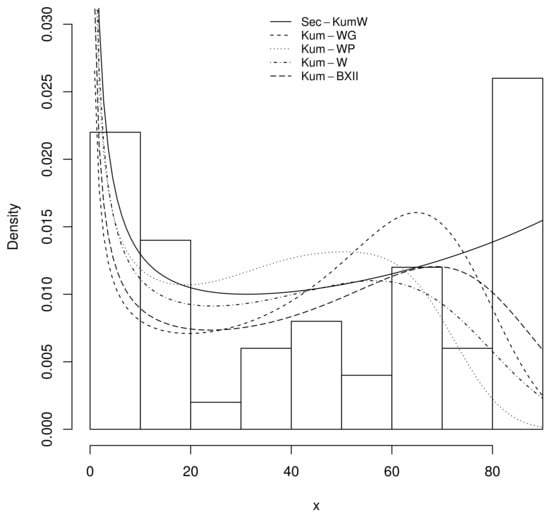
Figure 13.
Plots of the estimated fitted PDFs, including one of the Sec-Kum-W model (solid line) for the lifetimes of devices.
In Figure 13, we observe an excellent fit to the data for the estimated probability functions of the Sec-Kum-W distribution; the corresponding estimated PDF fits well with the histogram of the data.
4.2.2. Data: Failure Data of 6061-T6 Aluminum
The second dataset is given by [37] on the fatigue life of 6061-T6 aluminum coupons cut parallel to the direction of rolling and oscillated at 18 cycles per second. The dataset Table 6 consists of 101 observations with maximum stress per cycle 31,000 psi.

Table 6.
Failure data of 6061-T6 aluminum.
We adopt the same methodology as that developed in Section 4.2.1. First, some descriptive statistics about the data are provided in Table 7.

Table 7.
Descriptive statistics for the failure data of 6061-T6 aluminum.
A simple histogram analysis shows that the data are almost symmetrical, which is a case covered by the Sec-Kum-W distribution, as shown in Figure 1. The MLEs of the parameters of the considered models, along with the AIC, BIC, CAIC, and HQIC values, are given in Table 8.

Table 8.
MLEs of the parameters of the Sec-Kum-W, Kum-WP, Kum-WG, Kum-W, and Kum-BXII models with standard errors in parentheses, and AIC, BIC, CAIC, and HQIC values for the failure data of 6061-T6 aluminum.
The obtained values of the AIC, BIC, CAIC, and HQIC statistics reveal that the Sec-Kum-W is the best model in terms of fitting behavior. This can be observed in a more direct manner in Figure 14, where the estimated PDFs of the considered models are plotted.
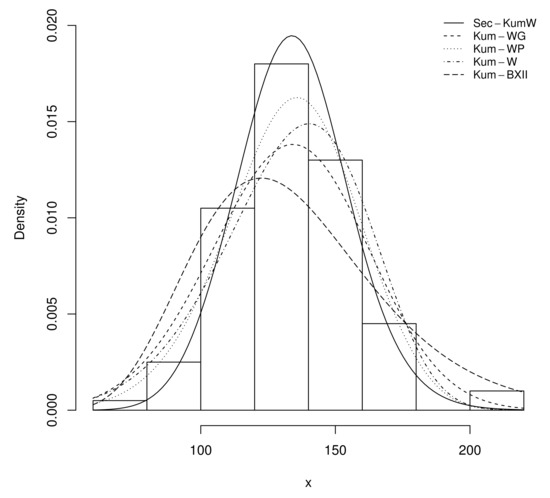
Figure 14.
Plots of the estimated fitted PDFs, including one of the Sec-Kum-W model (solid line) for the failure data of 6061-T6 aluminum.
In Figure 14, we see that the estimated PDF of the Sec-Kum-W model has captured the symmetric shape of the histogram, including its upper stick. This is not the case for the competitors.
4.2.3. Data: Sums of Skin Folds
As a third data set [38], data from 100 Australian female athletes were collected at the Australian Institute of Sport (AIS). We consider the data sum of skin folds for athletes in Table 9.

Table 9.
Sums of skin folds.
Again, we adopt the same methodology as that developed in Section 4.2.1. Some descriptive statistics about the data are provided in Table 10.

Table 10.
Descriptive statistics for the sums of skin folds.
A histogram analysis shows that the data are moderately right skewed, which is a case covered by the Sec-Kum-W distribution, as shown in Figure 1. The MLEs of the parameters of the considered models, along with the AIC, BIC, CAIC and HQIC values, are given in Table 10.
From Table 11, we see that the Sec-Kum-W model is the best; it has the smallest AIC, BIC, CAIC, and HQIC values. Thus, the Sec-Kum-W model presents a good fit to the data. We illustrate this claim in Figure 15.

Table 11.
MLEs of the parameters of the Sec-Kum-W, Kum-WG, Kum-WP, Kum-BXII, and W models with standard errors in parentheses, and AIC, BIC, CAIC, and HQIC values for the sums of skin folds.
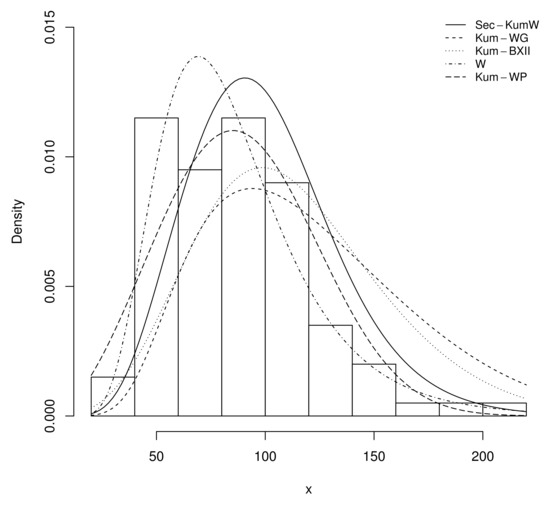
Figure 15.
Plots of the estimated fitted PDFs, including one of the Sec-Kum-W model (solid line) for the sums of skin folds.
From Figure 15, we see that the estimated PDF of the Sec-Kum-W distribution has captured the form of the histogram in a better manner than those of the competitor models.
5. Concluding Remarks
In this study, we introduced a new class of distributions, with properties based on the secant function. It is called the Sec-G class. The idea is to use the functionality of the secant function to create new trigonometric distributions based on baseline distributions. It is proved that the new class first-order stochastically dominates its corresponding baseline distribution, opening new horizons of modeling. Within this class, a new trigonometric distribution, the Sec-Kum-W distribution, has been thoroughly investigated. Here, we obtained the corresponding cumulative distribution and probability density functions and their expansions, and provide discussions of various types of moments and related functions. Moreover, the model parameters were checked via maximum likelihood estimation. We applied the new distribution to three real datasets: a lifetime of devices dataset, failure data of the 6061-T6 aluminum dataset, and a sum of the skin folds dataset. It is proved that the proposed secant Kumaraswamy-Weibull model outperforms important competitors, including the Kumaraswamy-Weibull, Kumaraswamy-Weibull geometric, Kumaraswamy-Weibull Poisson, Kumaraswamy Burr XII, and Weibull models. Hence, the practical part brought evidence that the proposed model can help in the analysis of survival data, material fatigue, among others, and we conjectured that it can also be applied to other areas of knowledge.
Author Contributions
Methodology, L.S., W.R.d.O., C.C.R.d.B., C.C., R.F. and T.A.E.F. All authors have read and agreed to the published version of the manuscript.
Funding
Wilson Rosa de Oliveira was partially funded by the Brazilian research council CNPq grants 421849/2016-9, 308748/2018-2 and 313767/2021-1.
Conflicts of Interest
The authors declare no conflict of interest.
Nomenclature
| Symbols | |
| vector of parameters of the continuous baseline distribution | |
| cumulative distribution function of the continuous baseline distribution | |
| probability density function of the continuous baseline distribution | |
| cumulative distribution function of the Sec-G class | |
| probability density function of the Sec-G class | |
| survival function of the Sec-G class | |
| cumulative hazard rate function of the Sec-G class | |
| hazard rate function of the Sec-G class | |
| quantile function of the continuous baseline distribution | |
| quantile function of the Sec-G class | |
| parameters of the Sec-Kum-W distribution | |
| X | random variable with a distribution into the Sec-G class |
| moments of the random variable | |
| E | expectation operator |
| mean of X | |
| moment of X | |
| variance of X | |
| central moment of X | |
| moment generating function of X | |
| characteristic function of X | |
| incomplete moment of X | |
| gamma function | |
| lower incomplete gamma function | |
| Lorenz curve | |
| Bonferroni curve | |
| general coefficient of X | |
| skewness of X | |
| kurtosis of X | |
| R | coefficient of reliability of X |
| Rényi entropy of X | |
| PDF of the order statistic of the Sec-G class | |
| value representing the data | |
| likelihood function of the Sec-G class | |
| log-likelihood function of the Sec-G class | |
| maximum likelihood estimate of | |
| Abbreviations | |
| exp-G | exponentiated generated |
| Kumaraswamy-G | Kumaraswamy generated |
| Marshall–Olkin-G | Marshall–Olkin generated |
| beta-G | beta generated |
| gamma-G | gamma generated |
| CDF | cumulative distribution function |
| Sec-G | secant generated |
| probability density function | |
| HRF | hazard rate function |
| Kum-W | Kumaraswamy-Weibull |
| Sec-Kum-W | secant Kumaraswamy-Weibull |
| MLE | maximum likelihood estimate |
| MSE | mean squared error |
| Kum-WG | Kumaraswamy-Weibull geometric |
| Kum-WP | Kumaraswamy-Weibull Poisson |
| Kum-BXII | Kumaraswamy-Burr XII |
| W | Weibull |
| AIC | Akaike information criterion |
| BIC | Bayesian information criterion |
| CAIC | consistent Akaike information criterion |
| HQIC | Hannan–Quinn information criterion |
References
- Gupta, R.D.; Kundu, D. Exponentiated exponential family: An alternative to Gamma and Weibull distributions. Biom. J. 2001, 43, 117–130. [Google Scholar] [CrossRef]
- Cordeiro, G.M.; de Castro, M. A new family of generalized distributions. J. Stat. Comput. Simul. 2021, 81, 883–898. [Google Scholar] [CrossRef]
- Marshall, A.; Olkin, I. A new method for adding a parameter to a family of distributions with applications to the exponential and Weibull families. Biometrika 1997, 84, 641–652. [Google Scholar] [CrossRef]
- Eugene, N.; Lee, C.; Famoye, F. Beta-normal distribution and its applications. Commun. Stat. Theory Methods 2002, 31, 497–512. [Google Scholar] [CrossRef]
- Zografos, K.; Balakrishnan, N. On families of beta- and generalized gamma-generated distributions and associated inference. Stat. Methodol. 2009, 6, 344–362. [Google Scholar] [CrossRef]
- Brito, C.R.; Rêgo, L.C.; Oliveira, W.R.; Gomes-Silva, F. Method for generating distributions and classes of probability distributions: The univariate case. Hacet. J. Math. Stat. 2019, 48, 897–930. [Google Scholar]
- Gilbert, G.K. The Moon’s Face: A Study of the Origin of Its Features; Bulletin of the Philosophical Society of Washington: Washington, DC, USA, 1895; Volume 12, pp. 241–292. [Google Scholar]
- Burr, I.W. Cumulative frequency functions. Ann. Math. Stat. 1942, 13, 215–232. [Google Scholar] [CrossRef]
- Raab, D. A cosine approximation to the normal distribution. Psychometrika 1961, 26, 447–450. [Google Scholar] [CrossRef]
- Nadarajah, S.; Gupta, A. The beta Fréchet distribution. Far East J. Theor. Stat. 2004, 14, 15–24. [Google Scholar]
- Lark, R.M. Modelling complex geological circular data with the projected normal distribution and mixtures of von Mises distributions. Solid Earth 2014, 5, 631–639. [Google Scholar] [CrossRef] [Green Version]
- Kumar, D.; Singh, U.; Singh, S.K. A new distribution using sine function: Its application to bladder cancer patients data. J. Stat. Appl. Probab. 2015, 4, 417–427. [Google Scholar]
- Souza, L. New Trigonometric Classes of Probabilistic Distributions. Ph.D. Thesis, Universidade Federal Rural de Pernambuco, Recife, Brazil, 2015. [Google Scholar]
- Souza, L.; Junior, W.R.O.; de Brito, C.C.R.; Chesneau, C.; Ferreira, T.A.E.; Soares, L. On the Sin-G class of distributions: Theory, model and application. J. Math. Model. 2019, 7, 357–379. [Google Scholar]
- Souza, L.; Junior, W.R.O.; de Brito, C.C.R.; Chesneau, C.; Ferreira, T.A.E.; Soares, L. General properties for the Cos-G class of distributions with applications. Eurasian Bull. Math. 2019, 2, 63–79. [Google Scholar]
- Mahmood, Z.; Chesneau, C.; Tahir, M.H. A new sine-G family of distributions: Properties and applications. Bull. Comput. Appl. Math. 2019, 7, 53–81. [Google Scholar]
- Chesneau, C.; Bakouch, H.S.; Hussain, T. A new class of probability distributions via cosine and sine functions with applications. Commun. Stat. Simul. Comput. 2019, 48, 2287–2300. [Google Scholar] [CrossRef]
- Jamal, F.; Chesneau, C. A new family of polyno-expo-trigonometric distributions with applications. Infin. Dimens. Anal. Quantum Probab. Relat. Top. 2020, 22, 1950027. [Google Scholar] [CrossRef] [Green Version]
- Jamal, F.; Chesneau, C.; Bouali, D.L.; Ul Hassan, M. Beyond the Sin-G family: The transformed Sin-G family. PLoS ONE 2021, 16, e0250790. [Google Scholar] [CrossRef] [PubMed]
- Chesneau, C.; Artault, A. On a comparative study on some trigonometric classes of distributions by the analysis of practical datasets. J. Nonlinear Model. Anal. 2021, 3, 225–262. [Google Scholar]
- Alzaatreh, A.; Lee, C.; Famoye, F. A new method for generating families of continuous distributions. Metron 2013, 71, 63–79. [Google Scholar] [CrossRef] [Green Version]
- Brito, C.C.R. Método Gerador de Distribuicoes e Classes de Distribuicoes Probabilisticas. Ph.D. Thesis, Universidade Federal Rural de Pernambuco, Recife, Brazil, 2014; p. 244. [Google Scholar]
- Cordeiro, G.M.; Ortega, E.M.M.; Nadarajah, S. The Kumaraswamy-Weibull distribution with application to failure data. J. Frankl. Inst. 2010, 349, 1399–1429. [Google Scholar] [CrossRef]
- MacGillivray, H.L. Skewness and asymmetry: Measures and orderings. Ann. Stat. 1986, 14, 994–1011. [Google Scholar] [CrossRef]
- Moors, J.J. A quantile alternative for kurtosis. J. R. Stat. Soc. Ser. D 1988, 37, 25–32. [Google Scholar] [CrossRef] [Green Version]
- Murthy, D.N.P.; Xie, M.; Jiag, R. Weibull Models; John Wiley and Sons, Inc.: Hoboken, NI, USA, 2004. [Google Scholar]
- Eissa, F.H. The Exponentiated Kumaraswamy-Weibull distribution with application to real data. Int. J. Stat. Probab. 2017, 6, 167–182. [Google Scholar] [CrossRef]
- Rasekhi, M.; Alizadeh, M.; Hamedani, G.G. The Kumaraswamy-Weibull geometric distribution with applications. Pak. J. Stat. Oper. Res. 2018, 14, 1–21. [Google Scholar] [CrossRef] [Green Version]
- Mead, M.E.; Afify, A.; Butt, N.S. The Modified Kumaraswamy-Weibull Distribution: Properties and Applications in Reliability and Engineering Sciences. Pak. J. Stat. Oper. Res. 2020, 16, 433–446. [Google Scholar] [CrossRef]
- Weisstein, E.W. Secant, From MathWorld—A Wolfram Web Resource. 2020. Available online: http://mathworld.wolfram.com/Secant.html (accessed on 19 September 2020).
- Kotz, S.; Lumelskii, Y.; Penskey, M. The Stress-Strength Model and Its Generalizations and Applications; World Scientific: Singapore, 2003. [Google Scholar]
- Rényi, A. On measures of entropy and information. In Proceedings of the 4th Berkeley Symposium on Mathematical Statistics and Probability; University of California Press: Berkeley, CA, USA, 1961; Volume 1, pp. 547–561. [Google Scholar]
- Souza, L.; Gallindo, L.; de Souza, L.S. SecKW: The SecKW Distribution. R Package Version 0.2. 2016. Available online: https://CRAN.R-project.org/package=SecKW (accessed on 21 October 2019).
- Aarset, M.V. How to identify bathtub hazard rate. IEEE Trans. Reliab. 1987, 36, 106–108. [Google Scholar] [CrossRef]
- Ramos, M.W.A.; Marinho, P.R.D.; Cordeiro, G.M.; Silva, R.V.; Hamedani, G. The Kumaraswamy-G Poisson family of distributions. J. Stat. Theory Appl. 2015, 14, 222–239. [Google Scholar] [CrossRef] [Green Version]
- Paranaiba, P.F.; Ortega, E.M.M.; Cordeiro, G.M.; Pascoa, M.A.R. The Kumaraswamy Burr XII distribution: Theory and practice. J. Stat. Comput. Simul. 2013, 83, 2117–2143. [Google Scholar] [CrossRef]
- Birnbaum, Z.W.; Saunders, S.C. Estimation for a family of life distributions with applications to fatigue. Appl. Probab. 1969, 6, 328–347. [Google Scholar] [CrossRef]
- Cook, R.; Weisberg, S. An Introduction to Regression Graphics; John Wiley & Sons: New York, NY, USA, 1994. [Google Scholar]
Publisher’s Note: MDPI stays neutral with regard to jurisdictional claims in published maps and institutional affiliations. |
© 2022 by the authors. Licensee MDPI, Basel, Switzerland. This article is an open access article distributed under the terms and conditions of the Creative Commons Attribution (CC BY) license (https://creativecommons.org/licenses/by/4.0/).